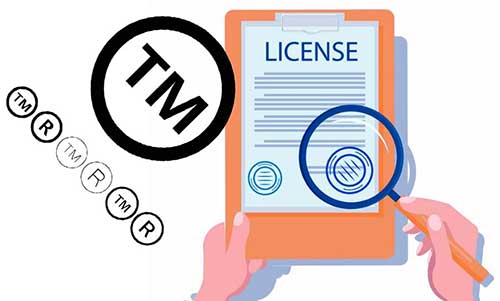TRADEMARK A trademark is something that we encounter on a regular basis. It is the…
Trademark Symbols And Registration In India

Trademark Marking is a commonly used practice to assign a status symbol to signify a word, logo, slogan, etc. as a Trademark. There are 3 types of trademark symbols, which are in use, often seen as “Superscripts” or a letter slightly above the brand name or logo. As a product is trademarked, after the product’s name or logo, a trademark status symbol is placed to inform the public that this item is trademarked and subsequently must not be reproduced (without permission). Unregistered trademarks are represented by letters ‘TM’, Service trademarks, used by brands involved in the service sector are represented by letters ‘SM’. Registered trademarks are the most used trademark, and are therefore enforceable represented by an ‘R’-enclosed in a circle or ‘®’This essentially serves as a notice to the public about the claim you have in that product or service. However, it is important to note here that a legally enforceable “claim” will be limited to ‘®’ only, as it signifies registration.
Registered Trademark Symbols
Registered Trademark Symbols refers to a name, slogan, or logo that has been officially registered with the Office of Registrar of Trademarks, Ministry of Industry and Commerce, Government of India. Registering a trademark is an essential step as then you have exclusive rights to that name/symbol and its status in your industry. This would also help file for infringement in case you found another business of a similar nature using g your name/symbol, and can take up legal action for such use of your name.
The presence of the ‘®’ symbol is not considered mandatory but it is indicative of the owner’s trademark claim, as well as the ‘identity’ of a trademark being registered under the law. A proprietor’s claim of the mark essentially lies in the ability to be distinguishable in the public’s eye along with the public’s perception and identification of such a mark that directs the consumers to take notice of the product or service.
This marking, as long as it is authentic, also indicates that the mark has passed the minimum threshold or legal requirements, which means it is not prohibited under law. To elaborate, under the Act, any trademark in order to be registered in India must not be prohibited under section 11 on relative grounds or under section 13 on absolute grounds. Further in cases where the trademark rights have been given to third parties, through licensing, such a symbol serves as a guarantee and ensures the public of its association with the owner of that mark.
Penalty Provisions under Indian Law
Assigning such symbols is mostly a matter of practice and not mandated under the law. In order to make those who otherwise might be unaware of the legality of a trademark, such a practice is essentially adopted.
The Indian Trademarks Act, 1999 however under Section 107 penalizes with imprisonment up to three years and fines, those individuals who are found to be falsely representing a trademark as ‘registered’, when in reality they are not. The section goes on to mention that any sort of representation with respect to a mark, wherein the word “registered” or any other expression, symbol or sign that indicates either expressly or impliedly of registration (such as ®, Reg. or Regd. etc.) shall be deemed to be registered under the Trademarks Registry.
In the landmark case of William Bailey (Birmingham) Ltd.(1935) 52, RPC 137it was observed that the applicants had intentionally used the words “Registered” in order to deceive the public and gain the advantage of such portrayed authentication which was considered to be an advantage they were not entitled to. Further, in the case of Sagar Beedi Works v. Bharath Beedi Works, 1981 PTC 269 the Bombay High Court held that when a mark is not registered but is referred to as “Registered” it is enough to conclude that the individual who is found to have done this, did it with an intention to unfairly gain advantage and that further, protection awarded in cases of ‘honest concurrent use’ under Section12 of the Act for such unregistered should not be permitted.
While there might not be a provision of law under the Trademark Act that mandates trademark marking, using a mark without completing the registration process shall punish the wrongdoer. Thus, using symbols such as ® or any similar indication of registration, not including ‘TM/SM’ is permissible only if in actuality, it has fulfilled the requirements for a valid trademark and is registered with the Trademarks Registry. This crucial but sometimes neglected step should be considered along with other compliance measures to not only avoid getting penalized for wrongful use but also to provide more surety to consumers with respect to the brand and its reputation.
Author: Nimrat Singh – a student of Symbiosis Law School (Noida), in case of any queries please contact/write back to us via email [email protected]



